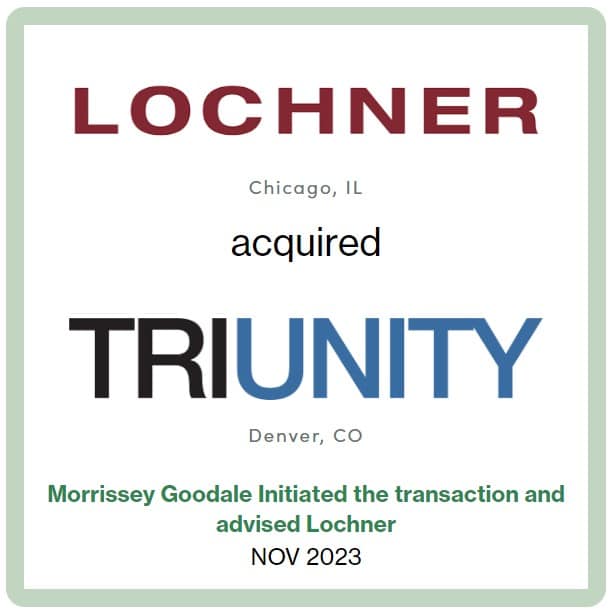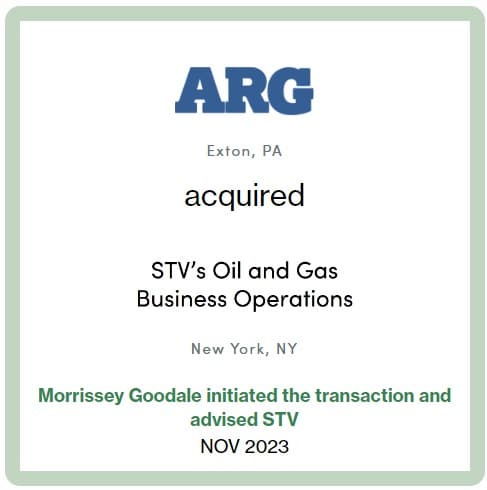Word on the street > AI Musings; What AI Does and Doesn’t Do—at Least for Now
Word on the Street: Issue 176
Weekly real-time market and industry intelligence from Morrissey Goodale firm leaders.

AI Musings
Mark’s article this week, “What AI Does and Doesn’t Do—at Least for Now,” is an excellent deep dive on the practical applications of AI in the industry. The whole “AI thing” continues to move so quickly that we thought we would set the table for Mark’s article by revisiting some of our perspectives and thoughts on AI in the industry from the past two years, as follows:
- In “We Need to Stop Innovating!” (Word on the Street Issue 169, October 9, 2023), we conducted an eye-opening interview with industry thought-leader and CEO of BST Global (Tampa, FL) Javier Baldor about how AI and machine learning will transform the AE and environmental consulting industry.
- In “Venture Capital for the AE Industry—The Why, When, How, and How Much” (Word on the Street Issue 157, July 10, 2023), we spoke with KP Reddy, founder and managing partner of Shadow Partners (Atlanta, GA), a seed-stage technology investment firm for the built environment. He knows a thing or two about AI start-ups in the AE and environmental industry—he and his team hear pitches from 30 new start-ups each week. On a related note, five of the most exciting start-up tech-enabled businesses for the built and natural environment from the Shadow Partners Incubator program will be presenting their ideas from the stage at our upcoming Southeast M&A and Business Symposium in Miami this March.
- In “The Acquisition That Changes Everything” (Word on the Street Issue 139, February 21, 2023), we imagined how a venture capital buy-out of one of the largest global design firms would launch a series of AI-driven changes that would put most traditional AE and environmental firms out of business and replace them with an app. (While at the same time improving client service and reducing costs for project owners. Ouch!)
- In “Artificial Intelligence: First- and Second-Order Effects for the AE Industry” (Word on the Street Issue 135, January 23, 2023), we used ChatGPT to write the first part of the article and then described how AI would transform how we do business and specific market opportunities that it presents.
- In “The CEO’s Diary: August 29, 2032, Reflections on the Past Decade” (Word on the Street Issue 117, August 29, 2022), we introduced AIesha, the trusted AI COO who always has the right answer, who never takes time off for golf vacations, and who has successfully replaced the former human COO of our CEO protagonist’s firm.
To connect with Mick Morrissey—email him at [email protected] or call/text at 508.380.1868.
What AI Does and Doesn’t Do—at Least for Now
Last week I had a chance to chat with Jason Shevrin, director of InfraSolutions, the innovation and technology division of McFarland Johnson (Binghamton, NY), a leading planning, technology, design, and construction services firm specializing in infrastructure. I wanted to catch up with Jason to get his thoughts on AI and its growing impact on the AE industry. Here’s what we talked about:

Jason, thanks for contributing to “Word on the Street.” Would you provide a brief overview of how you see artificial intelligence currently being used in the AE industry?

From my own experience and what I have observed, people in the industry are using AI to shave some peaks and execute some of the more time-consuming, mundane tasks a bit more quickly. And they are essentially using AI to do some of their work for them, as well—whether it’s updating a report, responding to a technical question, or developing an agenda, it’s being used all over the place for many things.

What are some specific applications of AI that you find particularly useful for project work?

There are many intriguing ways AI can be put to use. For example, you can use AI to create a document made up of many sources inside and outside your organization to appear as though it was written in one voice. Normally a task like that would take quite a bit of time and require a specific skill set. Or maybe you are producing a technical document and want to enhance graphics instead of just a chart. You could create infographics or maps or other complex visuals based on a relatively straight-forward narrative and a basic graphic. The caveat that comes with these and other uses is that the output always needs oversight, a backcheck, and so on. If you use AI, make sure you have the time and awareness to make sure it’s giving you back the value that’s needed. That said, you can train AI to do it better next time, and that’s really intriguing.

How does AI impact the collection, analysis, and utilization of data in projects?

AI is interesting in that the more you interact with it, the more productive it becomes. I can provide AI with my analysis and then challenge it to tell me other things I could do with that data that I don’t see. It might ask me if I have compared one set of data on page 72 of my report to another set of data I mentioned earlier in the report, or it might suggest other tests I could run against the data. It takes some time to get these kinds of answers, but it does still save significant time.

Is AI bulletproof in that regard?

It doesn’t work every time in every situation. Sometimes you spend an hour with it and figure out you could have done it more quickly yourself. But when it does work, it does save a lot of time. I’m probably batting about .400 with it right now.

Can AI design?

AI isn’t like Autodesk tools that have practical engineering methodologies built into them. But if you are trying to come up with preliminary sketches, if you give it some basic parameters, like the roof needs a 2% slope on this side and 8% on that side, and this many rainwater conductors, etc., it could give you a sketch if you are using a tool that can handle it. But AI can’t, for example, say how many electrical circuits I need for a 100-room hotel. It won’t know how to do that. Not yet anyway, unless you train it.

How do you see the role of professionals evolving with the increasing integration of AI in the AE industry? Is it more about collaboration or automation?

That is a good question. I want to lean toward automation. However, here’s where I think we need both—collaboration is going to happen with the AI tool as opposed to, say, you and me talking about it. The more you interact with AI, the more you collaborate with it toward automation. Yet, the end goal has to be automation and efficiency.

Are there ethical considerations or challenges associated with the use of AI, and how should the AE industry address them?

There are a number of considerations to put into play when you begin to think about using AI. For example, professionals are required to take into account the safety, welfare, and health of the public. We won’t get that from AI at this point. We need to be mindful of what we can use AI for and what we should and shouldn’t use it for—and provide that guidance. The same way we come up with rigorous processes for all the work we do, that same level of care needs to go into whatever AI produces on our behalf, whether it’s imagery, design contributions—whatever. All of it needs to be done with the safety and welfare in mind of those who will interact with our designs. How does that apply to things that won’t get built? Well, clients are paying for a level of service, so if you employ AI to save time, use that time to enhance the value of your service or product. To me, if there is content AI produced that you include in your deliverable, my feeling is you should disclose it. In any case, you at least have to make sure that the AI content is correct, applicable, etc.

What skills do AE professionals need to develop to effectively leverage AI in their work, and how can the industry support this skill development?

If you are going to put AI in your tool bag, you have to learn how to use it. It’s not a magic wand. You can train AI to do all kinds of things—I can train it to talk to others like it’s you, for example. Developing the skills to produce a persona is new, and it’s tricky. It requires knowing the right prompts and the right questions to ask so it doesn’t simply spit back what you put into it. There’s some formal training out there, but that aside, get in there and interact with it with a topic you are familiar with to get AI to give you the answers you know are right. Then apply the approach you develop through that collaboration of sorts to other topics that you know less or nothing about.
To paraphrase from the lyrics of Bachman-Turner-Overdrive, when it comes to AI, we ain’t seen nothin’ yet. To learn more about AI and how to responsibly incorporate it into your organization, call Mark Goodale at 508.254.3914 or email [email protected].
Market Snapshot: Surveying and Mapping (Part 2)
Weekly market intelligence data and insights for AE firm leaders.
Our last post featured overview, size, and outlook information for surveying and mapping within the AE industry. If you missed it, you can check it out here. This week we will cover drivers, trends, and hot spots.
Drivers
- Infrastructure development
- Real estate and construction activity
- State and local government investments
- Advancements in surveying and mapping technologies
- Environmental issues and regulations
- Urbanization
Market Trends
- Technology advancements have significantly impacted surveying and mapping practices. The adoption of GPS applications over the past 20 years has enabled survey data to be collected more quickly and accurately. In addition, tools such as UAVs, LiDAR, photogrammetry, and BIM models have not only made surveying and mapping more efficient but also expanded the breadth of its service applications.
- The use of mobile mapping systems in combination with the technologies mentioned above has allowed companies to collect massive amounts of geospatial data. To be able to collaboratively manage and analyze all this information, companies will need to be proficient in cloud-based Geographic Information System (GIS) platforms.
- By integrating AI algorithms and machine learning applications with GIS, the data collected by sensors and devices can quickly turn into insights, which can be leveraged to inform decisions.
- Surveying and mapping tools and GIS systems will increasingly be leveraged to improve environmental compliance as well as to monitor issues such as deforestation and coastal resilience. Furthermore, survey data is leveraged to build resilience predictive models that help engineers and planners better understand exposure to extreme weather events.
- Successful smart city projects will likely require robust security, management, and visualization of geospatial and remotely sensed data with GIS and BIM.
Hot Spots
- Fast-growing cities, primarily in the Southeast and Rocky Mountain regions
- Metro areas with high employment and concentration of surveying professionals: Houston, Denver, Raleigh, and Atlanta
To learn more about market intelligence data and research services offered by Morrissey Goodale, schedule an intro call with Rafael Barbosa. Connect with him on LinkedIn.
Weekly M&A Round Up

Congratulations to Lochner (Chicago, IL) (ENR #128): The leading transportation infrastructure planning and engineering services firm is expanding its professional talent and service offering in the transit & rail and municipal services markets with the acquisition of Triunity (Denver, CO). Triunity delivers program and project management and controls, construction management, and specialized communication systems and electrical engineering services for transit and rail agencies, complementary to Lochner’s infrastructure-focused transit and rail portfolio. We’re thankful that the Lochner team trusted us to initiate and advise them on this transaction.

Another congrats to STV (New York, NY) (ENR #37): The industry-leading EA firm will exit servicing the midstream oil and gas market after signing an agreement with Allied Resources Group (Exton, PA). While STV has worked in the oil and gas market for decades, its exit from this market emphasizes its commitment to the company’s core growth areas and other future-focused markets, transportation, buildings, and water. We feel privileged that the STV team trusted us to initiate and advise them on this transaction.
Another busy week of deals: It was another active week for industry M&A, and not surprisingly a new deal was announced in the Southeast, one of the fastest-consolidating regions in the U.S. Additional domestic deals were reported in MA, TX, PA, WV, and NY. Overseas we reported deals in the UK, Hungary, Norway, and Australia along with a deal in Canada. You can check all the week’s M&A news here.
Symposium Updates

Please welcome our new sponsor to the Southeast M&A and Business Symposium, Morningstar Law Group!
Early bird registration is now open for you to reserve your spot to network with 200 industry executives, investors, and experts in Miami this March.

Searching for an external Board member?
Our Board of Directors candidate database has over one hundred current and former CEOs, executives, business strategists, and experts from both inside and outside the AE and Environmental Consulting industry who are interested in serving on Boards. Contact Tim Pettepit via email or call him directly at (617) 982-3829 for pricing and access to the database.
Are you interested in serving on an AE firm Board of Directors?
We have numerous clients that are seeking qualified industry executives to serve on their boards. If you’re interested, please upload your resume here.
June 12-14, 2024 Las Vegas, NV
Western States M&A and Business Symposium
Join us for the 10th annual Western States Symposium, bringing together over 200 AE and environmental industry executives and investors in one of the world’s most vibrant and iconic cities.
Learn More
Subscribe to our Newsletters
Stay up-to-date in real-time.










